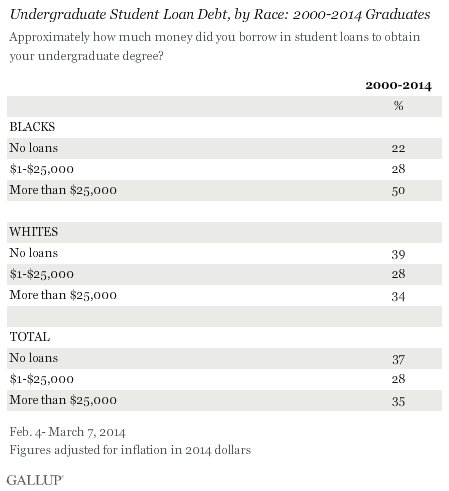Black college graduates carry more student debt
While student loan debt is a problem for most college graduates, it’s hitting one group significantly harder: black students.
A new analysis from Gallup found a significantly greater percentage of black college graduates carry student debt as compared to white students. Seventy-eight percent of black students graduate college with student loan debt, compared to 61% of white students.
Half of black graduates owe more than $25,000 in student loans
They’re also more apt to carry greater debt loads, with half of black students reporting they have more than $25,000 in student loan debt, compared to only 34% of white students.
Overall, 35% of 2000-2014 U.S. college graduates report graduating with more than $25,000 in student debt when adjusted for inflation–which shows that black students are carrying a larger burden than the general population.

A greater percentage of black students report carrying student debt and higher debt loads as compared to white students.
Greater debt hurts black graduates’ well-being
Consistent with an earlier report that found that greater student loan debt has a negative impact on graduates’ well-being, black students are less likely to thrive financially and feel happy with their jobs and communities.
Only 17% of 2000-2014 black college graduates are classified as thriving in the area of financial well-being, compared with 31% of 2000-2014 white college graduates and 29% of all college graduates during this time period.
And only a third of recent black college graduates (34%) report liking what they do everyday and being motivated to achieve their goals, compared to 43% of recent white graduates.
Only 27% of black graduates report thriving in the area of community well-being, which includes liking where you live, feeling safe, and having pride in your community, while 39% of white graduates report satisfaction in this area.
While debt may not be the only reason black graduates lag behind whites in well-being after college, it’s certainly a factor.
Overall, college graduates with large debt levels are more stressed and less financially successful than their debt-free counterparts.
Financial aid not keeping up with rising college costs
While student debt is a nationwide problem, particularly for recent graduates and the millennial generation, it’s quite discouraging that it’s hitting one race harder than others.
With black students less likely than white students to attend and graduate college, statistics like these are troubling because they may discourage black students from applying to college for fear of ending up in debt.
Additionally, since black students are more likely than white students to be from low-income families, you’d think that these students would be receiving significant financial aid, particularly in the form of grants and scholarships to help them avoid loans.
As it turns out, however, low-income students are actually being hit hardest by the rise in college costs, and financial aid hasn’t kept up.
Paying for college without loans
Fortunately, there are several colleges that offer significant financial aid for qualified low-income students of all races, which can help more students overall reduce the amount of student loan debt they are forced to take out for college.
It’s also worth checking out the top colleges for different ethnic groups and races, which allows you to compare colleges’ graduation rates, locations and returns on investment after 20 years.
And there are many ways to make college more affordable without being forced to turn to loans. We help match students with quality colleges that won’t leave them with significant debt.
If you’re already struggling with student loan debt, we can also help you reduce your payments and manage your debt better. Feel free to call us at 1-888-234-3907 for a free consultation or send us a message and we’ll get back to you within 24 hours.
first generation, race, student loan debt, student loan repayment, student loans
